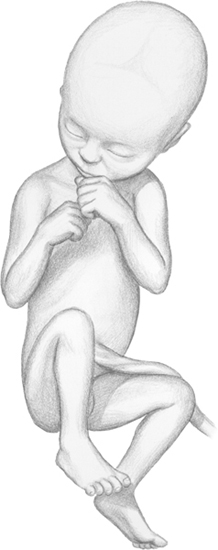1. How Big Is Your Baby?
The crown-to-rump length of your
growing baby is 5 to 5½ inches (12.5 to 14cm) by this week. Weight of
the fetus is about 5¼ ounces (150g).
2. How Big Are You?
If you put your fingers sideways and
measure, your uterus is about two finger-widths (1 inch) below your
bellybutton. It’s the size of a cantaloupe or a little larger.
Total weight gain to this point
should be 10 to 13 pounds (4.5 to 5.8kg), but this can vary. If you’ve
gained more weight than this, talk to your healthcare provider. You may
need to see a nutritionist. You still have more than half of your
pregnancy ahead of you, and you’ll definitely gain more weight.
3. How Your Baby Is Growing and Developing
Baby continues to develop, but the rapid growth rate slows.
Ultrasound can detect some fetal
problems. If one is suspected, further ultrasound exams may be ordered
to follow baby’s development as pregnancy progresses.
Blood from your baby flows to the
placenta through the umbilical cord. In the placenta, oxygen and
nutrients are carried from your blood to the fetal blood. At birth,
baby must go rapidly from depending on you for oxygen to depending on
its own heart and lungs. The foramen ovale closes at birth, and blood
goes to the right ventricle, the right atrium and the lungs for
oxygenation. It is truly a miraculous conversion.

By this week, baby is about
5 inches (12.5cm) from crown to rump.
It looks much more human now.
4. Changes in You
Does Your Back Ache?
Between 50 and 80% of all pregnant women
have back and hip pain at some time. Pain usually occurs during the
third trimester as your tummy grows larger. However, pain may begin
early in pregnancy and last until well after delivery (up to 5 or 6
months).
It’s more common to have mild backache
than severe problems. Some women have severe back pain after excessive
exercise, walking, bending, lifting or standing. Some women need to be
careful getting out of bed or getting up from a sitting position. In
extreme cases, some women find it difficult to walk.
The hormone relaxin may be part of the
problem. It’s responsible for relaxing joints that allow your pelvis to
expand to deliver your baby. However, when joints relax, it can lead to
pain in the lower back and legs. Other factors include your weight gain
(another good reason to control your weight), larger breasts and your
bigger tummy, which can cause a shift in posture.
Lumbar-spine pain (LSP) is an
aching feeling that spreads throughout the center lower back. It often
begins in the first or second trimester. If you’ve had lower-back pain
before pregnancy, you may experience this discomfort during pregnancy.
A prenatal yoga class may offer relief. Staying off your feet is also a
good remedy.
A change in joint mobility may cause a
change in your posture and may cause discomfort in the lower back,
especially during the last part of pregnancy. The growth of the uterus
moves your center of gravity forward, over your legs, which can affect
the joints around the pelvis. All your joints are looser. Hormone
increases are likely causes. Check with your healthcare provider if
back pain is a problem for you.
Actions You Can Take to Relieve Back Pain.
What can you do to prevent or lessen your pain? Try some or all of the
following tips as early in pregnancy as possible. They’ll pay off later
in pregnancy.
• Watch your weight gain; avoid gaining too much weight or gaining weight too fast.
• Stay active; continue exercising during pregnancy.
• Lie on your side when you sleep.
• Get off your feet and lie down for 30 minutes on your side.
• Practice good posture.
• If you have other children, take a nap when they take theirs.
• It’s OK to take acetaminophen for back pain.
• Use heat on the painful area.
• If pain becomes constant or more severe, talk to your healthcare provider about it.
When you have lower-back pain, use an ice
pack for up to 30 minutes three or four times a day. If pain lasts,
switch to a heating pad, sticking with the same regimen. Stretching
gently may also help.
Prenatal massage may help relieve
pain—ask your healthcare provider about it. He or she may be able to
suggest some qualified massage therapists. Or he or she may suggest a
lower-back brace or pregnancy support garment.
Exercise may help relieve back pain.
Swimming, walking and nonimpact aerobics may be beneficial.
Discomfort may also indicate more serious problems. Bring up any concerns you have with your healthcare provider.